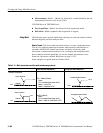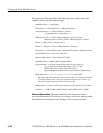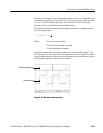
Creating and Using Math Waveforms
3- 190
CSA7000 Series, TDS7000 Series, & TDS6000 Series Instruments User Manual
The syntax that follows describes valid math expressions, which can be quite
complex (in excess of 100 characters long):
<MathWaveform> : = <Expression>
<Expression> := <UnaryExpression> | <BinaryExpression>
<UnaryExpression> := <UnaryOperator> ( <Term> )
| <UnaryOperator> ( <Expression> )
<BinaryExpression> := <Term> <BinaryOperator> <Term> | <Scalar>
<BinaryOperator> <Term> | <Term> <BinaryOperator> <Scalar>
<Term> := <Waveform> | ( <Expression> )
<Scalar> := <Integer> | <Float> | <Meas--Result> | <Variable>
<Waveform> := <ChannelWaveform> | <ReferenceWaveform> | <MathWaveform>
<ChannelWaveform> := Ch1 | Ch2 | Ch3 | Ch4
<ReferenceWaveform> := Ref1 | Ref2 | Ref3 | Ref4
<MathWaveform> := Math1 | Math2 | Math3 | Math4
<UnaryOperator> := Average | Integral | Derivative | Invert | Sqrt | Exp
|log10|loge|Fabs|Sin|Min|Max|Ceil|Cos|Tan
|ASin|Sinh|ACos|Cosh|ATan|Tanh|Floor
| Spectral Magnitude | Spectral Phase | Spectral Real | Spectral Imag
<BinaryOperator>:=+|--|/|*|==|!=|<|<=|>|>=|CHS|EXX
The logical operators generate a vector that is all 0.0 or 1.0. Operators && and
| | are not provided, but if x and y are expressions equal to 0 or 1, then x*y is
the same as x&&y and (x+y)>0.99 is the same as x| |y.
<Meas--Result> := meas1 | meas2 | meas3 | meas4 | meas5 | meas6 | meas7 | meas8
<Variable> :>= VAR1 | VAR2 | VAR3 | VAR4 | VAR5 | VAR6 | VAR7 | VAR8 |
Waveform Differentiation. The math capabilities of the instrument include
waveform differentiation. This allows you to display a derivative math waveform
that indicates the instantaneous rate of change of the waveform acquired.


















